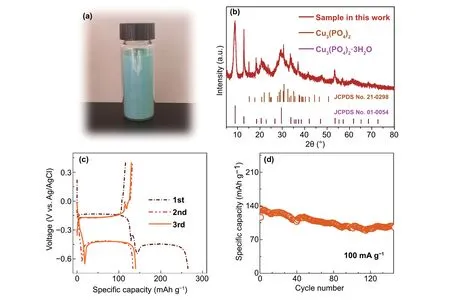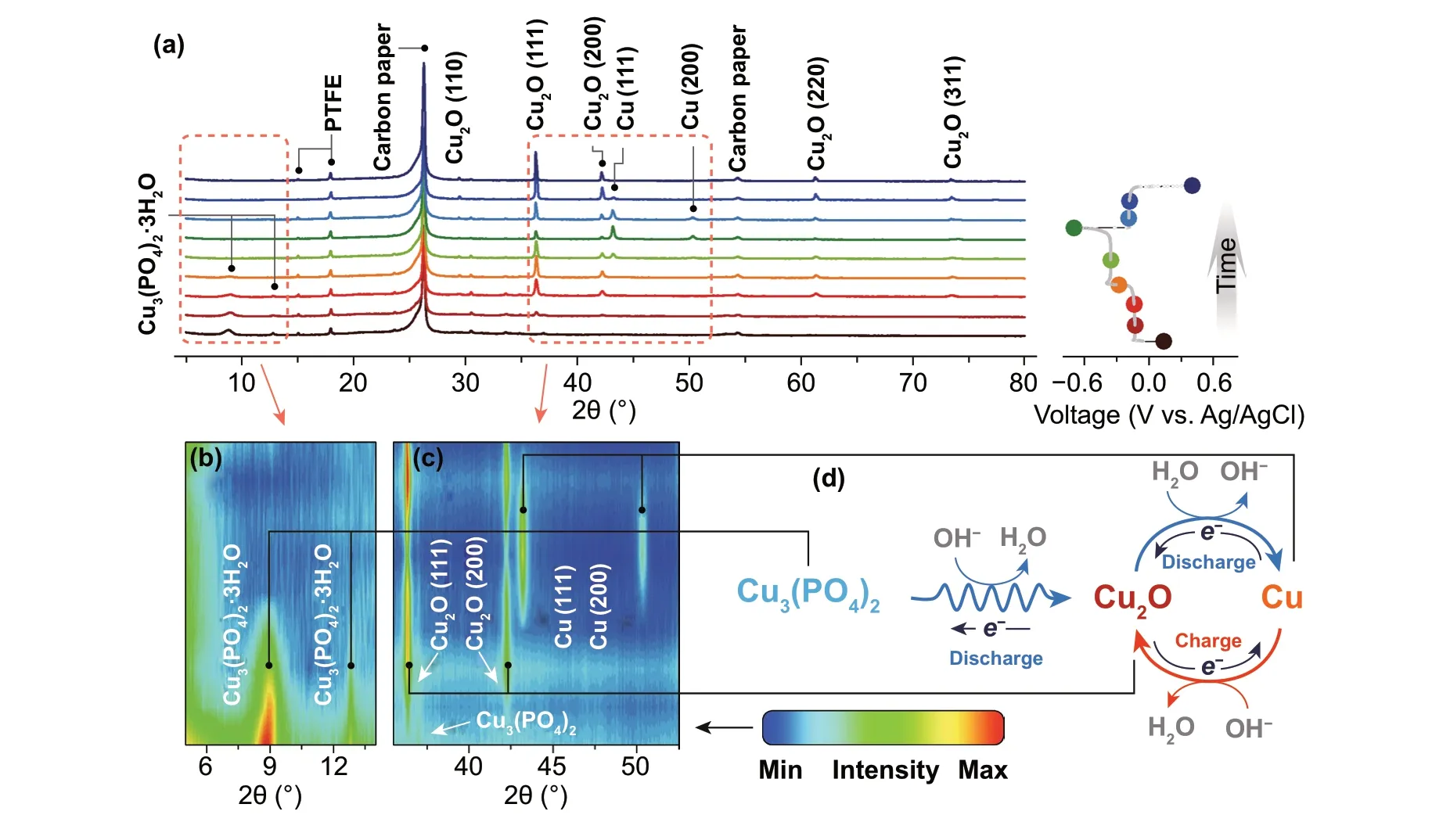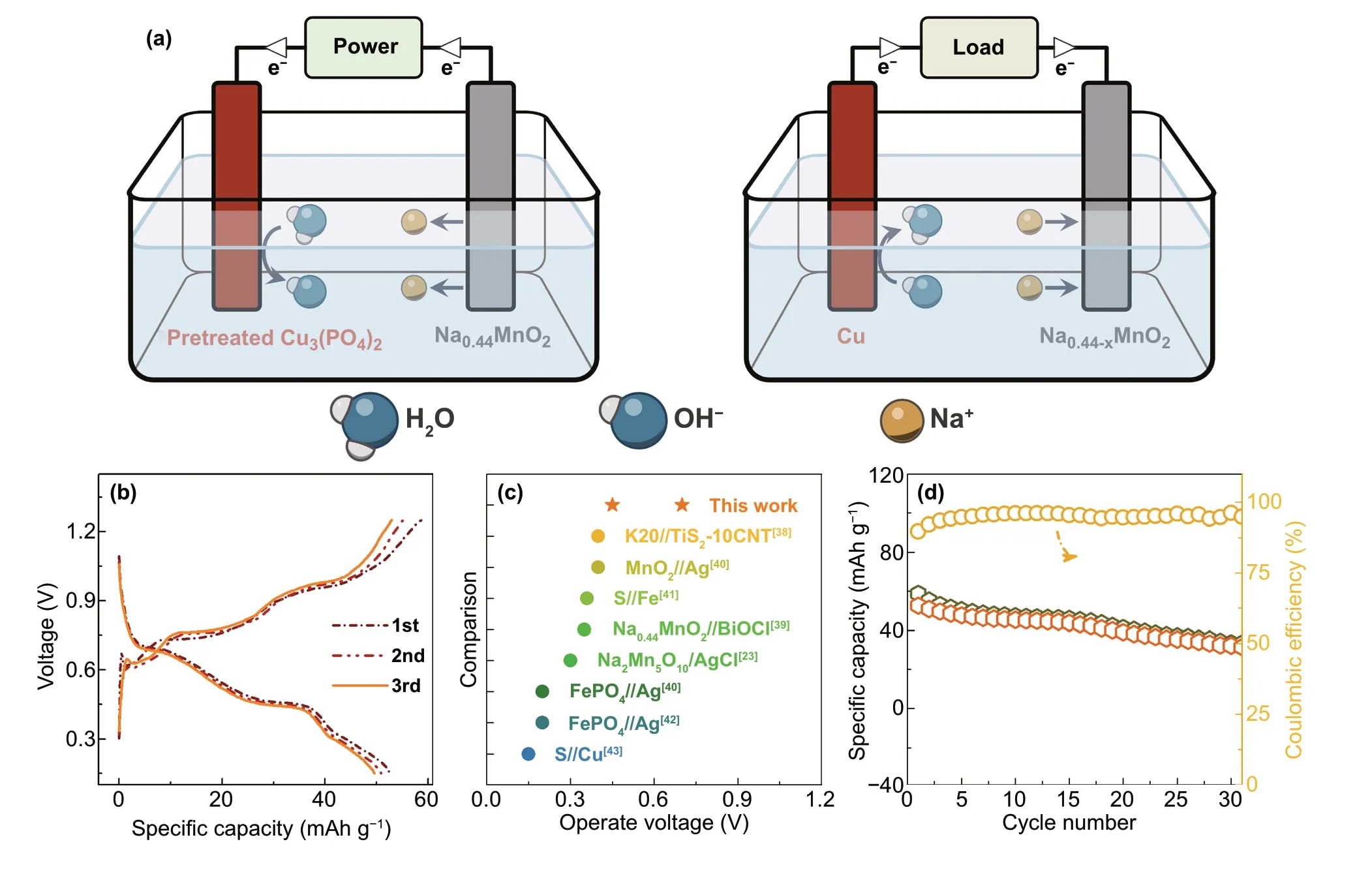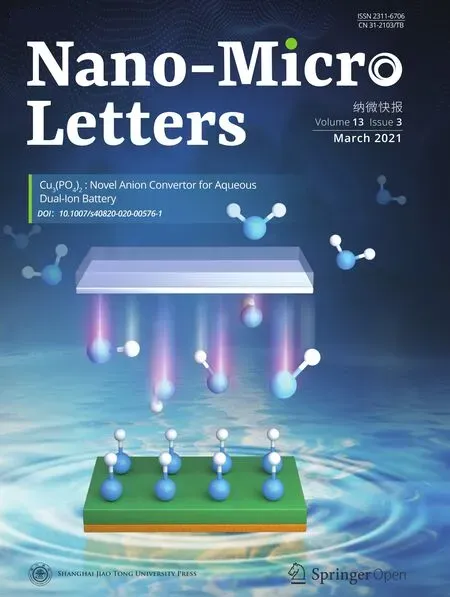Cu3(PO4)2: Novel Anion Convertor for Aqueous Dual‑Ion Battery
2021-03-08HaoxiangYuChenchenDengHuihuiYanMaotingXiaXikunZhangZhenBoWangJieShu
Haoxiang Yu, Chenchen Deng, Huihui Yan, Maoting Xia, Xikun Zhang, Zhen‑Bo Wang , Jie Shu,3
ABSTRACT Electrode materials which can reversibly react with anions are of interest for aqueous dual‑ion batteries. Herein, we propose a novel anion electrode, Cu3(PO4)2, for constructing an aqueous dual‑ion cell. The Cu3(PO4)2 electrode can operate in a quasi‑neutral condition and deliver a reversible capacity of 115.6 mAh g−1 with a well‑defined plateau at −0.17 V versus Ag/AgCl. Its reaction mechanism shows that Cu3(PO4)2 decomposes into Cu2O and subsequently is converted into Cu during the initial discharge process. In the following charge process, Cu is oxidized into Cu2O. It suggests Cu3(PO4)2 reacts with OH− ions instead of PO43− ions after the initial discharge process and its potential thereby depends upon the OH− ions concentration in electrolyte. Additionally, an aqueous dual‑ion cell is built by using pretreated Cu3(PO4)2 and Na0.44MnO2 as anode and cathode, respectively. During cycling, OH− ions and Na+ ions in electrolyte can be stored and released. Such a cell can provide a discharge capacity of 52.6 mAh g−1 with plateaus at 0.70 and 0.45 V, exhibiting the potential of application. This work presents an available aqueous dual‑ion cell and provides new insights into renewable energy storage and adjustment of the OH− ions concentration in aqueous buffer solution.
KEYWORDS Dual‑ion battery; Aqueous electrolyte; Cu3(PO4)2; Electrochemistry; Three‑electrode cell
1 Introduction
For the storage of energy coming from renewables such as solar and wind, numerous efforts have been dedicated to the development of rechargeable battery over past several decades [1, 2]. Among the multitudinous explored recharge‑able batteries, aqueous dual‑ion battery as the novel energy storage device has attracted intensive attention recently because of its availability, low cost, high safety and eco‑friendliness [3-6]. Its concept is different from that of tradition rocking‑chair battery in which anions or cations migrate across electrolyte and then react with anode and cathode [7, 8]. For aqueous dual‑ion battery, anions react reversibly with the electrode, whereas cations do the same way in the other electrode. It is developed from dual‑carbon batteries or dual‑graphite batteries as scientists find that anions can be inserted into graphite [9, 10]. The first pro‑totype of dual‑ion batteries used nonaqueous electrolytes and carbonaceous electrodes are proposed by McCullough et al. [11]. In that patent, the electrochemical behavior of this battery is described according to the “dual‑intercalation” mechanism. Thereafter, continuous progress is made to the development of dual‑ion batteries [12-14]. Although tradi‑tional dual‑ion batteries using organic electrolytes (including ionic liquid electrolytes) exhibit high safety, high working voltages (normally > 3 V), and reasonable specific capacity (~ 80 mAh g−1), the flammability and toxicity of organic electrolytes make them suffer from the safety issues [13, 15-22]. These problems hinder their wide application. To solve these problems, dual‑ion batteries with nonflamma‑ble and low toxicity aqueous electrolytes have been pro‑posed, and several configurations such as Ag/MnO2[23], NaTi2(PO4)3/Bi [24], and NaTi2(PO4)3/Ag [25, 26] have been demonstrated and fabricated so far. Notably, these reported systems use silver (Ag) and bismuth (Bi) as the electrodes to capture the anions. Although the performance of these materials shows decent, they possess several draw‑backs which need to be conquered. Ag is a little bit expen‑sive in price, whereas Bi can hardly react with anions in a mild solution. Thus, constructing an available aqueous dual‑ion battery which can cycle in a quasi‑neutral condition is of the great importance and desired.
The update of aqueous dual‑ion battery depends on the selection of electrode materials which acts as its key components. Many literatures have reported the electrode materials for releasing/storing the cations [27, 28]. Yet studies for investigating the anion containers are relatively less. Hence, we herein demonstrate a novel anion container, Cu3(PO4)2, for constructing an aqueous dual‑ion cell. This material can operate in a quasi‑neutral condition with well‑defined plateaus and good performance, and its price is lower than that of Ag, although its reaction mechanism is far different from our original vision. We also use the pre‑treated Cu3(PO4)2as anode to assemble the aqueous dual‑ion cell coupled with Na0.44MnO2as cathode. It presents well‑defined operating plateaus and good cycling performance.
2 Results and Discussion
Cu3(PO4)2is an inorganic compound which is composed of copper cations and phosphate anions. Due to its insolubility in water, Cu3(PO4)2can be prepared by the facile precipita‑tion method. The typical synthesis is described in supporting information. The as‑obtained powder is sky blue material as shown in Fig. 1a. X‑ray diffraction (XRD) pattern (Fig. 1b) suggests that two phases exist in this powder, which are Cu3(PO4)2and Cu3(PO4)2·3H2O, respectively, according to the two reference patterns. Besides, most of diffraction peaks are found to show the large full width at half maximum, indicative of its small crystallite size. The scanning electron microscope (SEM) images prove this result. As observed in Fig. S1a, b, the Cu3(PO4)2powder consists of countless nanosheets with thickness around 25 nm, providing large surface area to contact with the electrolyte. Additionally, the water content in this powder is measured by thermo‑gravimetric (TG) analysis (Fig. S2). About 6% of mass is lost below 200 °C, corresponding to the elimination of the physically absorbed and zeolitic water [29].
Cu3(PO4)2selected as the electrode material in this work is based on its low thermodynamic solubility product [30]. We think when the Cu3(PO4)2electrode is discharged, Cu will be produced and subsequently a metal‑sparingly soluble salt electrode is constructed until Cu3(PO4)2is vanished. The half reaction should be as follows:

Its potential thus can be given by:

Fig. 1 a Digital photo and b XRD pattern of Cu3(PO4)2. c Galvanostatic discharge/charge profiles of Cu3(PO4)2 between −0.7 and 0.4 V versus Ag/AgCl at 100 mA g−1, and d the corresponding cycling performance

Finally, the potential of Cu3(PO4)2electrode is calculated to be −0.22 V versus Ag/AgCl.
To verify the aforementioned half reaction and corre‑sponding potential, the Cu3(PO4)2electrodes are fabricated and tested in three‑electrode cells. Figure 1c, d exhibits the galvanostatic discharge/charge profiles of Cu3(PO4)2elec‑trode and its corresponding cycling performance. Two dis‑tinct plateaus around −0.14 and −0.40 V versus Ag/AgCl is observed upon the initial discharge process, whereas only one plateau at −0.17 V versus Ag/AgCl appears in the recharge process. This case leads to that the initial discharge capacity (265.1 mAh g−1) is much higher than the follow‑ing recharge capacity (115.9 mAh g−1). We consider that the large irreversible capacity loss during initial cycle is attributed to the formation of several intermediates as some reported metal oxides [31, 32], which can be reacted with lithium ions in the first discharge process. Additionally, the difference between calculated potential and the experimental one is slight. In the following second and third cycles, the large irreversible capacity losses almost disappear, and the charge capacities of Cu3(PO4)2electrode reach to 132.6 and 129.9 mAh g−1, respectively. The differential dQ/dV plots of Fig. 1c are displayed in Fig. S3. An increase in charge capacity may be owing to the fact that electrolyte does not contact well with Cu3(PO4)2electrode before cycling. After 45 cycles, the Cu3(PO4)2electrode can deliver a reversible capacity of 115.6 mAh g−1with 87.2% of its second capac‑ity. Even after 145 cycles, the reversible capacity can still be maintained at 96 mAh g−1. These results suggest the good cycling performance. If any defects could be introduced into this active material, the cycling performance may be better [33, 34].

Fig. 2 a XRD patterns of Cu3(PO4)2 electrode during cycling. The contour map for the corresponding XRD patterns in the 2θ range of b 5-14° and c 35.5-52.5°. d Reasonable mechanism for Cu3(PO4)2 electrode during the electrochemical reaction
What are the intermediates during discharging and the corresponding mechanism? To answer these two ques‑tions, we have characterized the Cu3(PO4)2electrodes at various states of discharge by using XRD measurement. The obtained results depicted in Fig. 2 are far different from our original vision. For an as‑prepared Cu3(PO4)2electrode, diffraction peaks belonged to Cu3a(PO4)2and Cu3(PO4)2·3H2O can be defined. Since PTFE binder is electrochemically inactive, we select it as an internal standard to conduct quantitative phase analysis. With dis‑charging to the first plateau at −0.14 V versus Ag/AgCl, the Cu3(PO4)2and Cu3(PO4)2·3H2O diffraction peaks in intensity slowly decrease (Fig. 2b), while two new diffrac‑tion peaks assigned to the (111) and (200) facets of Cu2O phase appear (Fig. 2c), suggesting that the Cu3(PO4)2and Cu3(PO4)2·3H2O phases slowly decompose into Cu2O. During discharging on the second plateau around −0.40 V versus Ag/AgCl, we found that the intensities of the Cu2O diffraction peaks in electrode is still decreasing with the formation of Cu phase until the voltage is at −0.7 V versus Ag/AgCl. Thus, the intermediate upon initial discharging is Cu2O. In the recharge process, Cu is converted into Cu2O instead of Cu3(PO4)2, which is the main reason for the ini‑tial irreversible capacity loss. As a result, the electrochemi‑cal reaction of the Cu3(PO4)2electrode during cycling can be described as:


The corresponding mechanism is schematically illustrated in Fig. 2d.
According to the electrochemical mechanism mentioned above, the Cu3(PO4)2electrode reacts with OH−ions instead of PO43−ions after initial discharge process, and its potential depends upon the concentration of OH−ions in electrolyte. The voltage profiles of Cu3(PO4)2electrodes in electrolytes with different pH validate this result (Fig. S4). It should be noted that although Cu3(PO4)2electrode provides larger specific capacity and lower plateau in 0.75 M NaH2PO4electrolyte and 0.75 M Na3PO4electrolyte, respectively, their cycling performances (Fig. S5) are inferior to that of Cu3(PO4)2electrode in 0.75 M Na2HPO4electrolyte (Fig. 1d). Nevertheless, an aqueous dual‑ion cell can still be constructed and the corresponding schematic is depicted in Fig. 3a. As viewed, we select Na0.44MnO2as cathode due to its low cost and eco‑friendliness [35-37]. Its voltage pro‑files in 0.75 M NaH2PO4electrolyte and 0.75 M Na2HPO4electrolyte are shown in Figs. S6 and S7, respectively. During charging, Na+ions and OH−ions are released by the Na0.44MnO2and pretreated Cu3(PO4)2electrodes, respec‑tively. Meanwhile, this cell can increase the concentration of NaOH in electrolyte. Upon discharging, these two ions are captured by the cathode and anode, respectively, leading to the reduction in the concentration of NaOH. As a result, this aqueous dual‑ion cell can not only modify the concentration of OH−ions in electrolyte, but also provide electrical energy. The reaction of this cell can be written as follows:

Fig. 3 a Schematic of pretreated Cu3(PO4)2/Na0.44MnO2 dual‑ion cell for charging and discharging (pretreated Cu3(PO4)2 electrodes is that the Cu3(PO4)2 electrodes is discharged and recharged in half cell for one cycle). b Galvanostatic discharge/charge profiles of pretreated Cu3(PO4)2/Na0.44MnO2 dual‑ion cell. c Operating voltage of pretreated Cu3(PO4)2/Na0.44MnO2 dual‑ion cell compared to the cells from previous studies. d Cycling performance of pretreated Cu3(PO4)2/Na0.44MnO2 dual‑ion cell

Figure 3b displays galvanostatic discharge/charge pro‑files of pretreated Cu3(PO4)2/Na0.44MnO2dual‑ion cell. Due to the presence of irreversible capacity loss in the ini‑tial cycle, the Cu3(PO4)2electrode needs to be pretreated before the dual‑ion cell assembly. For the pretreatment, the Cu3(PO4)2electrode is discharged and subsequently recharged for 1 cycle. As observed in Fig. 3b, this as‑fab‑ricated dual‑ion cell can provide a discharge capacity of 52.6 mAh g−1at 0.5 C based on the mass of Na0.44MnO2. Thus, thexvalue in Na0.44‑xMnO2can be calculated, being 0.19. Two well‑defined plateaus are observed at 0.70 and 0.45 V. By contrast, recently reported desalination batter‑ies, such as Na2Mn5O10//AgCl [23], TiS2//K20 [38], and BiOCl//Na0.44MnO2[39], displayed the operating plateaus only at ~ 0.3, ~ 0.4, and ~ 0.1 V, respectively. The detailed comparison for operating voltage of pretreated Cu3(PO4)2/Na0.44MnO2dual‑ion cell in this work with other cells in the literatures [23, 38-43] is plotted in Fig. 3c and Table S1. It is worth noting that the pH value changes during cycling as shown in Fig. S8, indicating that this system can adjust the OH−ions concentration in aqueous electrolyte. Besides, XRD patterns of Na0.44MnO2in dual‑ion cell during cycling are characterized as displayed in Fig. S9. The diffraction peaks of Na0.44MnO2show a quasi‑regular change, suggest‑ing that the variation of Na0.44MnO2during cycling is quasi‑reversible. The result is also in good agreement with previ‑ous study [44]. Figure 3d presents the cycling performance of this cell. It can retain the capacity of 43.8 mAh g−1after 15 cycles. When cycled to 31 cycles, the dual‑ion cell still provides 31.5 mAh g−1, showing its potential of application.
3 Conclusions
In summary, we propose a novel electrode material Cu3(PO4)2as an anion container for aqueous dual‑ion cell. The sample prepared by a simple precipitation method consists of two phases which are Cu3(PO4)2and Cu3(PO4)2·3H2O. When tested in the three‑electrode cell, it can deliver a reversible capacity of 115.6 mAh g−1with a charge plateau of −0.17 V versus Ag/AgCl. Our inves‑tigation for the reaction mechanism of Cu3(PO4)2reveals that the initial capacity loss of this material comes from the decomposition of Cu3(PO4)2into Cu2O, and such trans‑formation is irreversible. Besides, Cu3(PO4)2reacts with OH−ions instead of PO43−ions after the initial discharge process. Eventually, an available aqueous dual‑ion cell has been successfully constructed by applying pretreated Cu3(PO4)2and Na0.44MnO2as anode and cathode. It can provide a discharge capacity of 52.6 mAh g−1with plateaus at 0.70 and 0.45 V, exhibiting its potential of application. On the basis of this work, our next study shall focus on adjust‑ment of the OH−ions concentration in electrolyte by using this dual‑ion cell.
AcknowledgementsThis work is supported by NSAF joint Fund (U1830106), Ningbo S&I Innovation 2025 Major Special Program (2018B10061), and K.C. Wong Magna Fund in Ningbo University.
Open AccessThis article is licensed under a Creative Commons Attribution 4.0 International License, which permits use, sharing, adaptation, distribution and reproduction in any medium or format, as long as you give appropriate credit to the original author(s) and the source, provide a link to the Creative Commons licence, and indicate if changes were made. The images or other third party material in this article are included in the article’s Creative Com‑mons licence, unless indicated otherwise in a credit line to the material. If material is not included in the article’s Creative Com‑mons licence and your intended use is not permitted by statutory regulation or exceeds the permitted use, you will need to obtain permission directly from the copyright holder. To view a copy of this licence, visit http://creat iveco mmons.org/licen ses/by/4.0/.
Supplementary InformationThe online version of this article (https://doi.org/10.1007/s4082 0‑020‑00576‑1) contains supplementary material, which is available to authorized users.
杂志排行
Nano-Micro Letters的其它文章
- Hierarchical Magnetic Network Constructed by CoFe Nanoparticles Suspended Within “Tubes on Rods” Matrix Toward Enhanced Microwave Absorption
- Solution‑Processed Transparent Conducting Electrodes for Flexible Organic Solar Cells with 16.61% Efficiency
- High‑Energy and High‑Power Pseudocapacitor–Battery Hybrid Sodium‑Ion Capacitor with Na+ Intercalation Pseudocapacitance Anode
- Chemical Coupled PEDOT:PSS/Si Electrode: Suppressed Electrolyte Consumption Enables Long‑Term Stability
- Metallic Graphene Nanoribbons
- Armoring Black Phosphorus Anode with Stable Metal–Organic‑Framework Layer for Hybrid K‑Ion Capacitors
